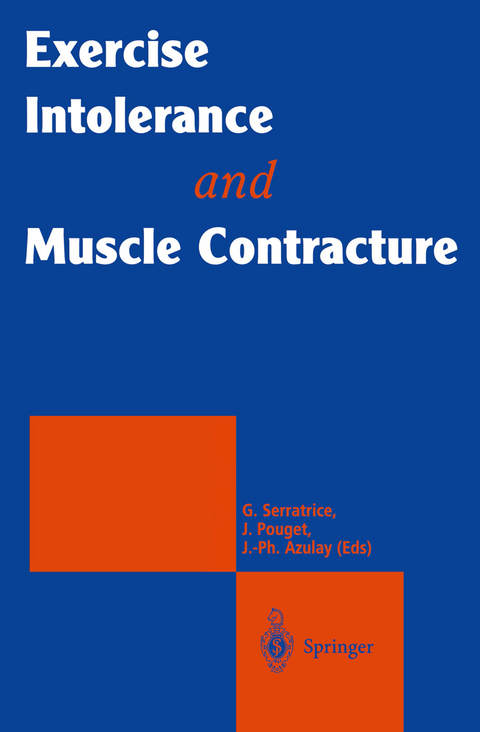
Exercise Intolerance and Muscle Contracture
Seiten
1999
Springer Editions (Verlag)
978-2-287-59669-8 (ISBN)
Springer Editions (Verlag)
978-2-287-59669-8 (ISBN)
The main themes presented in this volume are exercise intolerance and muscle contracture. Likewise exercise intolerance is sometimes due to dystrophinopathy, it self causing contractures. Exercise intolerance and muscle contracture could seem well known, even obsolete.
The main themes presented in this volume are exercise intolerance and muscle contracture. These two topics could seem different at first sight but share common clinical features. For instance, symptoms of exercise intolerance are myalgias and cramps but metabolic contractures as well. Likewise exercise intolerance is sometimes due to dystrophinopathy, it self causing contractures. Therefore, it is justified to gather these two syn dromes in one study. Exercise intolerance and muscle contracture could seem well known, even obsolete. It is not right. A reappraisal of these has be come necessary for two reasons. First of all there are many new causes of exercise intolerance; secondly, the pathophysiology remains ob scure in particular for muscle contracture and a clear classification is probably possible. There is no book devoted to exercise intolerance and muscle contrac ture. This volume is divided in two parts related to the above topics. The two sections are introduced by a didactic and general overview, describ ing the main symptoms, classification and classical etiology. The other chapters, written by the best experts, present the recent advances in these syndromes and show many new aspects: new glycogenosis or mitochondriopathies, dystrophinopathies, malignant hyperthermia, my otonic disorders. Pathophysiology and classification of persistent con tractures are described as well as therapy. Each chapter is thoroughly referenced, representing important progress in research in the field.
The main themes presented in this volume are exercise intolerance and muscle contracture. These two topics could seem different at first sight but share common clinical features. For instance, symptoms of exercise intolerance are myalgias and cramps but metabolic contractures as well. Likewise exercise intolerance is sometimes due to dystrophinopathy, it self causing contractures. Therefore, it is justified to gather these two syn dromes in one study. Exercise intolerance and muscle contracture could seem well known, even obsolete. It is not right. A reappraisal of these has be come necessary for two reasons. First of all there are many new causes of exercise intolerance; secondly, the pathophysiology remains ob scure in particular for muscle contracture and a clear classification is probably possible. There is no book devoted to exercise intolerance and muscle contrac ture. This volume is divided in two parts related to the above topics. The two sections are introduced by a didactic and general overview, describ ing the main symptoms, classification and classical etiology. The other chapters, written by the best experts, present the recent advances in these syndromes and show many new aspects: new glycogenosis or mitochondriopathies, dystrophinopathies, malignant hyperthermia, my otonic disorders. Pathophysiology and classification of persistent con tractures are described as well as therapy. Each chapter is thoroughly referenced, representing important progress in research in the field.
Part 1: Exercise Intolerance .... Part 2: 1. Reconciling language differences in describing states of muscle shortening: muscle contracture and related conditions. 2. Physiology and clinical classification. 3. Pathological aspects of muscle contracture. 4. The enigma of muscle contractures. 5. Contractures in Emery-Dreufuss syndrome. 6. Arthrogrypopsis and spinal muscular atrophy. 7. Contractures and congenital muscular dystrophy: new date. 8. Therapy of muscle contractures.
| Erscheint lt. Verlag | 1.6.1999 |
|---|---|
| Zusatzinfo | 19 Illustrations, black and white; XVI, 208 p. 19 illus. |
| Verlagsort | Paris |
| Sprache | englisch |
| Maße | 155 x 235 mm |
| Themenwelt | Medizinische Fachgebiete ► Chirurgie ► Unfallchirurgie / Orthopädie |
| Medizin / Pharmazie ► Medizinische Fachgebiete ► Neurologie | |
| Medizin / Pharmazie ► Medizinische Fachgebiete ► Sportmedizin | |
| Studium ► 1. Studienabschnitt (Vorklinik) ► Physiologie | |
| ISBN-10 | 2-287-59669-0 / 2287596690 |
| ISBN-13 | 978-2-287-59669-8 / 9782287596698 |
| Zustand | Neuware |
| Haben Sie eine Frage zum Produkt? |
Mehr entdecken
aus dem Bereich
aus dem Bereich
Buch | Softcover (2023)
Urban & Fischer in Elsevier (Verlag)
CHF 85,40
für Studium und Praxis unter Berücksichtigung des …
Buch | Softcover (2022)
Medizinische Vlgs- u. Inform.-Dienste (Verlag)
CHF 39,20


